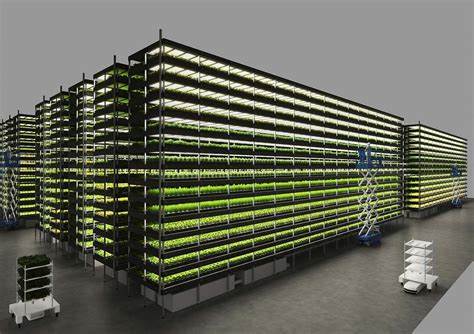
Vertical Farms in Industrial and Retail Spaces: Revolutionizing Urban Agriculture
Introduction
Vertical farming is an innovative approach to agriculture that has gained significant traction in recent years, particularly in urban areas where land is limited. By utilizing vertical space within industrial and retail spaces, this modern farming method offers numerous advantages and opportunities for sustainable food production. This article aims to explore the concept of vertical farming in industrial and retail spaces, its historical background, key concepts, main discussion points, case studies, current trends, challenges, future outlook, and the significance of this revolutionary approach.
Historical Background
Vertical farming has roots dating back to the early 20th century, with the concept of growing plants vertically in stacked layers or using hydroponics systems. However, it wasn’t until the late 1990s that commercial vertical farms started gaining prominence. The development of efficient LED lighting, advancements in hydroponics, and the growing need for localized food production in urban areas contributed to the evolution of vertical farming in industrial and retail spaces.
Key Concepts and Definitions
Vertical farming in industrial and retail spaces involves the cultivation of crops within controlled environments, often utilizing hydroponics, aeroponics, or aquaponics systems. Hydroponics refers to the method of growing plants without soil, using nutrient-rich water solutions. Aeroponics takes it a step further by misting the roots of plants with a nutrient solution, while aquaponics integrates the cultivation of plants with the rearing of aquatic animals, creating a mutually beneficial ecosystem.
Main Discussion Points
Benefits of vertical farms in industrial and retail spaces
Vertical farms offer increased food production in urban areas, reducing the reliance on traditional agriculture methods that require vast expanses of land. By utilizing vertical space, these farms maximize production capacity while minimizing land use. Furthermore, vertical farming minimizes transportation costs and carbon footprint associated with long-distance food supply chains.
Design and technology considerations for vertical farms in industrial and retail spaces
The layout and architecture of vertical farms play a crucial role in optimizing plant growth and productivity. Design elements such as vertical stacking, efficient use of space, and proper lighting systems ensure that plants receive adequate light, nutrients, and airflow. Automation and smart systems enable optimal monitoring and control of environmental conditions, ensuring optimal plant health and growth. Additionally, energy-efficient lighting systems are essential for providing the specific light spectrum required for different growth stages of plants.
Economic viability and market potential of vertical farms in industrial and retail spaces
While initial investment costs for vertical farms can be high, the economic viability lies in long-term benefits. Vertical farming eliminates the need for large-scale land acquisition, reduces water usage, and minimizes crop losses due to pest infestations or adverse weather conditions. The market demand for locally grown, sustainably produced food presents significant opportunities for vertical farm products. However, challenges such as scaling up operations and achieving competitive pricing remain key considerations.
Case Studies or Examples
Several successful vertical farms in industrial and retail spaces have paved the way for this revolutionary farming method. Gotham Greens, a leading urban agriculture company, operates vertical farms across multiple cities, supplying fresh produce to local markets year-round. Their innovative approach of integrating rooftop greenhouses with distribution centers has significantly reduced transportation costs and ensured the freshness of their products.
Current Trends or Developments
The advancement of vertical farming technology is driven by ongoing research and development. Recent trends focus on enhancing crop yield and quality through sophisticated monitoring and control systems. Researchers are exploring the use of artificial intelligence and machine learning algorithms to optimize plant growth and resource allocation. Additionally, advancements in vertical farming have led to the cultivation of a wider variety of crops, expanding the market potential even further.
Challenges or Controversies
Despite the numerous benefits, vertical farming faces challenges, including high initial investment costs and operational complexities. The sophisticated technology required for optimal plant growth and the need for skilled labor can increase the overall expenses. Controversies surrounding the use of genetically modified organisms (GMOs) and synthetic fertilizers in vertical farming raise concerns about the sustainability and health implications of these practices.
Future Outlook
The future of vertical farms in industrial and retail spaces holds immense potential. Continued advancements in technology, such as the integration of robotics and AI, will further optimize production efficiency. Vertical farms have the potential to become an integral part of urban planning, providing a sustainable and localized food source while reducing the strain on traditional agriculture. With ongoing research and development, vertical farming has the capability to revolutionize the way we produce and consume food.
Conclusion
Vertical farming in industrial and retail spaces offers a sustainable solution to the challenges of urban food production. By maximizing space and resources, these farms increase food production, reduce transportation costs, and minimize environmental impact. The successful case studies and ongoing technological advancements highlight the viability and potential of vertical farming. As we move towards a future with limited land availability and growing population, vertical farms have the potential to reshape the agricultural landscape and ensure food security.
References
Despommier, D. (2010). The rise of vertical farms. Scientific American, 301(5), 80-87.
Li, X., & Kubota, C. (2009). Effects of supplemental light quality on growth and phytochemicals of baby leaf lettuce. Environmental and Experimental Botany, 67(1), 59-64.
Sanyal, M., & Lu, N. (2017). Vertical farming: A sustainability perspective. Sustainable Cities and Society, 28, 419-427.